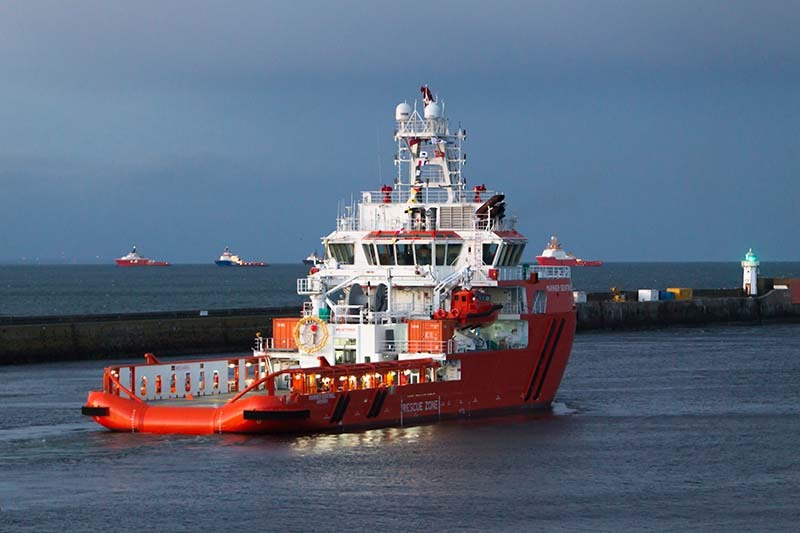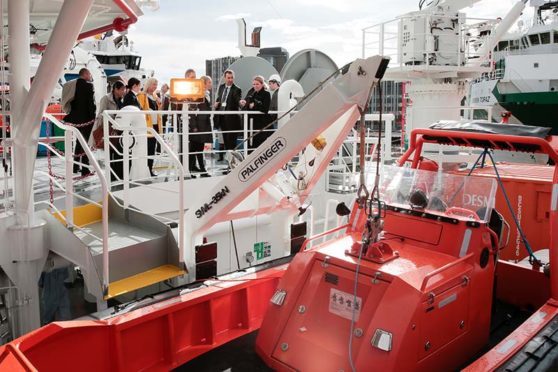Aberdeen-based Sentinel Marine continues to break new ground for emergency response and rescue vehicles (ERRVs) in the North Sea with further additions to its fleet of state-of-the-art purpose-built vessels.
Biscay Sentinel – the seventh EERV to be built by the firm – arrived in Aberdeen last month and is about to go into service. The British-flagged vessel, measuring 62m (203.5ft) in length, was built at the Cosco Dalian shipyard in China.
She is part of an overall £110 million investment by the firm aimed at revolutionising the North Sea’s ERRV fleet. The new ships are multi-role so that, along with their primary function of protecting offshore workers, they can perform a wide range of other tasks.
Some of the other vessels in the fleet are used for operations such as cargo storage, oil recovery rescue towing and dynamic positioning, making Sentinel’s ERRVs the youngest and most efficient in the North Sea.
A further two vessels are under construction at the yard in China and are expected to come into service by the end of 2018. Sentinel Marine has plans to further expand its fleet within the next four to five years.
Sentinel Marine chief executive officer Rory Deans said: “This has represented a significant investment – especially from a relatively young company – but we know there is huge potential for these multi-role vessels.
“It’s estimated that around 30% of the North Sea sector’s 125 ERRVs are at least 30 years old and many were originally fishing boats or supply vessels which were repurposed for their current use.
“Sentinel Marine’s investment is a game-changer: not only are we creating a purpose-built fleet with ships that use the very latest technology, but one that has capabilities beyond a traditional role of protecting lives at sea.
“The technology enables our ships to be highly fuel-efficient, and the multi-role function allows them to perform additional tasks. This means that they are a very attractive proposition for operators: anything that performs more than one role is going to deliver cost and operational efficiencies.”

Earlier this year Sentinel Marine was awarded a contract to provide a patrol vessel to be chartered by the European Fisheries Control Agency (EFCA) in international and EU waters. Lundy Sentinel is being used by EU fisheries inspectors as a platform for the monitoring, boarding and inspection of fishing boats as well as associated transport and support vessels.
She is the first of the fleet to be utilised by the fisheries sector, with all other vessels providing support for the offshore industry. Last year, Mariner Sentinel was christened at Aberdeen harbour before taking up operations for Statoil in the Mariner field to the east of Shetland, where she joined Portland Sentinel.
INEOS Breagh has Forties Sentinel and Sentinel Ranger supporting its operations in the southern North Sea, while Fastnet Sentinel will be based in the Golden Eagle and Buzzard fields over a four-year period for Nexen Petroleum UK. Cygnus Sentinel is under long-term contract to Neptune.
The two remaining vessels to be built in this round of investment – Bailey Sentinel and Malin Sentinel – are nearing completion and are due to be operational by the end of the year.
Mr Deans believes there will be significant opportunities to further expand the Sentinel fleet – the size of which allows for the firm to provide a service to clients 365 days
of the year as they always have at least one vessel not on charter.
This ability to rotate means that there is no down time when ships return to port to crew change or replenish supplies.
He added: “We expect to be able to introduce even more new vessels as older ships are retired due to the fact that most operators place stringent age stipulations on the ERRVs that they hire.
“Reliability is a major issue for operators, as the availability of an ERRV can impact on ability to produce oil and gas, therefore directly affecting the bottom line.
“If an ERRV was to be unavailable to service a specific field, for example due to a break down, then the operator may have to shut down production because of the safety implications for the workforce.
“The aging nature of the North Sea fleet means that there will be increased demand for new-build ERRVs in future, and we believe that the combination of technology and efficiency that we can offer sets us apart.”
